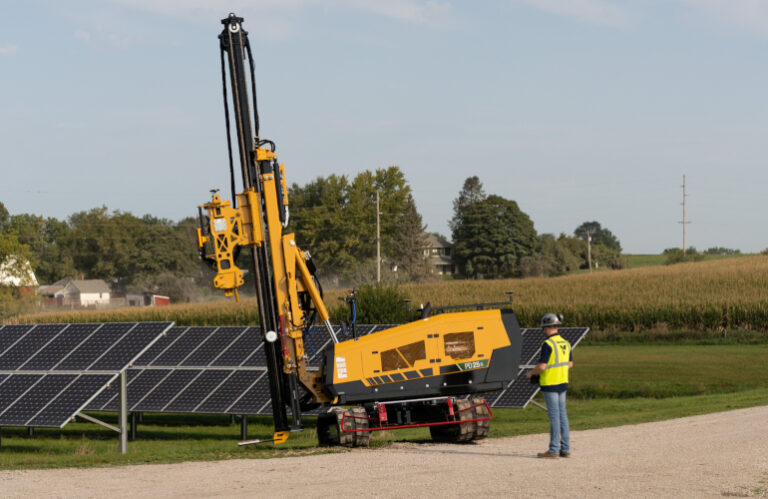Vermeer has unveiled the PD25R pile driver, designed to meet the changing demands of the growing solar energy market. This new model has a piling capacity of 7.5 meters, allowing solar contractors to install longer piles for larger solar panels and on varied terrain.
 “The PD25R represents a significant advancement in piling technology,” said Ed Savage, product manager at Vermeer. “We incorporated twelve years of customer feedback to create a machine that offers greater flexibility, capacity and optimized performance.”
“The PD25R represents a significant advancement in piling technology,” said Ed Savage, product manager at Vermeer. “We incorporated twelve years of customer feedback to create a machine that offers greater flexibility, capacity and optimized performance.”
Powered by a robust 74 hp (55.2 kW) Tier 4 Final/Stage V engine, the Vermeer PD25R delivers impressive performance in the field. It reaches transport speeds of up to 4.0 km/h and generates significant hydraulic power for optimal downforce. This power combination allows the machine to operate in a wide range of ground conditions, including challenging terrain.
The innovative design of the Vermeer PD25R pile driver includes a telescopic mast and a rotating upper half, eliminating the need for assembly and disassembly. This design allows rapid rotation and positioning of the mast, significantly optimizing set-up and take-down time. For contractors, this means less non-value added time between jobs and the ability to complete more installations per day.
With a piling capacity of 7.6 m (25 ft) and the ability to expose up to 25.4 cm (10 in) of piles above ground, the PD25R demonstrates remarkable versatility. These features allow the machine to meet various installation requirements for solar panels, inverters and battery storage systems.
The Vermeer PD25R is designed to support automation and includes features such as auto plumb, auto home, auto aim and an optional laser receiver. The machine is also compatible with Trimble or Carlson GPS systems, improving accuracy and consistency during installation. This automation helps improve installation quality and shortens the learning curve for new operators, helping contractors address labor shortages and training challenges in the industry.
Equipped with advanced technological features, the PD25R improves operational efficiency and management. Intelligent on-rig diagnostics provide operators with specific explanations and prescribed troubleshooting steps, helping to quickly resolve issues and optimize uptime. Integrated with telematics connectivity, this system provides contractors with comprehensive insight into the performance, location and maintenance needs of their machines. These combined technologies allow operators of different skill levels to run the machine efficiently, while project managers get real-time data for better fleet management and resource allocation.
The Vermeer PD25R is equipped with rubber tracks and exerts a low ground pressure of only 5.7 psi. This design improves buoyancy and turning ability, minimizes ground disturbance and allows continued work in a variety of weather conditions, including rain. Combined with its compact footprint (309.9 cm long, 256.5 cm transport width and 307.3 cm operating width), the PD25R offers adaptability to various workplaces.
Safety features of the PD25R include an automatic stop, headway speed control based on hammer height and tilt, and bumper bars for optional automation systems.
Vermeer is also introducing new row-to-row technology as an available option on the PD25R pile driver, improving the automation of solar installations.
“With the optional row-to-row technology, operators no longer need to manually rotate or pivot the machine to the next row,” Savage explains. “This technology means less room for operator error during the installation process and can lead to optimized training for novice operators. For solar contractors who choose this feature, this translates to faster installation times and improved overall project effectiveness.”
The row-to-row system uses GPS to locate waypoints and complete installation accurately and consistently. When combined with Vermeer’s point-to-point system, it enables comprehensive machine navigation throughout the entire solar field with minimal operator input. This level of automation not only speeds up the installation process, but also enables a high degree of accuracy, reducing the need for costly rework and improving the overall quality of solar field construction.
News item from Vermeer


